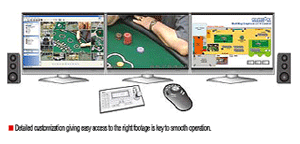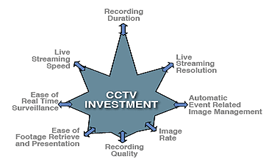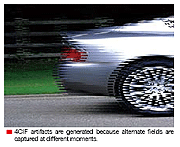Providing digital CCTV for casinos is a serious business and a real technological challenge because of the large number of cameras involved and the demand for continuous, real-time recording 24/7, which, increasingly, is for retention periods of 14 days or more.
Providing digital CCTV for casinos is a serious business and a real technological challenge because of the large number of cameras involved and the demand for continuous, real-time recording 24/7, which, increasingly, is for retention periods of 14 days or more.
Earlier analog systems were huge but simple, consisting of many cameras linked to many VCRs using many tapes. Their drawbacks included the cost of labor required to continuously service the VCRs and tapes, and the time-consuming process involved in producing evidential footage, the latter of which was often of poor quality owing to tape and mechanical wear. By their very nature, digital systems are able to avoid all this. Many digital CCTV systems on the market take the easy option and simply swap analog for digital, while maintaining the same basic philosophy of recording every channel on channel-based hardware multiplied to fit.

On the other hand, there are also professional multi-channel digital CCTV systems which are security- and user-focused. These don't just do the same but digitally, they provide a variety of new functions and unprecedented ease of use that was unimaginable with analog. They offer security-enhancing features to make casino surveillance much easier and more efficient, and real management of the cameras and images, locally and/or remotely, for both live and/or recorded playback. For instance, the ability to jump backwards in time, produce multi-camera footage and send it over the network to a review stationall with a single mouse clickis light years on from the earlier cassette changing, rewinding and handling. This demonstrates how modern technology can now support the real management of events or gaming tables, not just of individual cameras.
It makes sense for anyone making a significant investment in digital storage capacity to ensure that the right scenes are recorded, and that an employee has not turned a camera so that it does not 'see' illicit activity. Nowadays, securityoriented CCTV systems are very good at detecting when a camera is obscured or repos i t ioned. They constantly monitor the cameras , checking their status, image quality, lighting and position, and automatically trigger an alarm if tampering is detected.
 Quality Versus Retention Times
Quality Versus Retention Times
With hundreds, sometimes thousands of gaming cameras per casino, all recording 25 or 30 images per second continuously, systems have to 'digest' and manage huge numbers of images- -something which requires enormous recording capacity. Fourteen days' worth of real-time images from 100 cameras, for example, equates to an enormous 3.629 billion images.
Achieving this in an affordable manner is what most of today's vendors are concentrating on, but often at the cost of other important quality criteria, namely recording quality and ease of image retrieval. When economies are made by sharing digital resources, the quantity of recordings can be increased, but only by diminishing the quality of images, and vice versa. This then begs the question, why invest heavily in recording if there are problems retrieving the right images for playback, and, if eventually the value of a card or chip cannot be read, or the video pictures of the player's movements are blurred?
The quality of the footage and the ease of producing it should be fundamental in any system. The latter determines efficiency and enables the casino operator to combat player and employee misconduct. In digital systems, there are simple physical rules, and the resources for image processing and image storage have affordable limits. Recording durations can be augmented, for example, by reducing the number of images per second, by diminishing the image format, or by applying a higher compression level.
Image Resolution
In the digital world, image formats (resolutions) can be extremely versatile. The commonly-used format expressions for images date from analog cameras. These are based on the native PAL or NTSC resolutions, and they are: QCIF (PAL: 176 x 144 pixels, NTSC: 166 x 120 pixels) CIF (PAL: 352 x 288 pixels, NTSC: 320 x 240 pixels) 2CIF (PAL: 704 x 288 pixels, NTSC: 704 x 240 pixels) 4CIF (PAL: 704 x 576 pixels, NTSC: 704 x 480 pixels)
QCIF images are little bigger than a stamp, and need very little data compared to full screen images, but their quality is extremely poor when enlarged for analysis. 4CIF would appear to be the best resolution, but this is not necessarily a clear-cut thing. It is a fact of life that any standard PAL camera is not capable at any given time, of producing an image with a higher vertical resolution then 288 lines (240 lines for NTSC). What it does is simply alternate 50(PAL) or 60(NTSC) times per second between images composed of odd lines and images composed of even lines. Each of these so-called 'fields' has 288 or 240 lines.

The 4CIF image is obtained by combining these two fields together, which theoretically doubles the vertical resolution. But in fact, it only does this when there is no motion in the image. This is because each field is captured at a different moment, and if there is motion, then the resultant image has very annoying 4CIF artifacts, as depicted in the picture of the moving car.
Therefore, because capturing a sharp image of fast motion in a game is important for a casino CCTV system, there can be real doubt about whether 4CIF is actually best for this purpose. There are software methods of de-interlacing, which remove these unpleasant artefacts, but they require additional processing power, and in the end, rather than increasing the information contained in the image, they actually reduce it. These methods tend to make the image look better, but since it is redrawn electronically, they actually remove it further from the truth. Additionally, the data need for 4CIF images is double of that for 2CIF images, so 4CIF also doubles hard disk storage requirement.
Some low-cost systems avoid any need for de-interlacing by setting the image sharpness low enough to avoid revealing those fine 4CIF artefacts. However, their 4CIF images still need double the disk space, and the image only has information equal to, or less than 2CIF. Nowadays, state-of-the-art systems allow the user to set the image format for each camera to 4CIF, 2CIF, or another option. This enables him to select the optimum format for this purpose and avoid the use of 4CIF for images with lots of movement.
The latest high-resolution digital IP cameras, called megapixel cameras, look very promising because they are not bound by the old PAL and NTSC limits. But, because they also demand huge amounts of network bandwidth and storage, they are not as yet ready to replace all the analog cameras in big casinos. They aren't fast enough yet and they would both multiply the already huge demand for hard disks, as well as generate an additional requirement for an enormous pre-storage network infrastructure. Nevertheless, it does make sense, even today, to use certain megapixel IP cameras for taking high resolution snapshots triggered manually or automatically.
This takes us into the field of hybrid systems, where analog cameras for real-time watching and recording a re combined wi th IP c ams for high-resolution photos and digitally zooming in for that close-up of the player's fingers. Any system should handle the IP cams exactly in the same way as all other cameras and, for example, allow multiple viewer playback of time-linked analog streams and IP photos.
Image Compression
All systems use image compression to reduce bandwidth and recording space, and how they do this is important. It is vital to remember that an image format of, for example, 704 x 576 pixels for 4CIF only tells us about the image sizeit does not specify the actual resolution. An object only a few pixels big may still not be visible because of the compression algorithm used.

Most CCTV systems use the MPEG2 or MPEG 4/H264 algorithms which were originally developed to serve the aims of the multimedia world. In CCTV, where demands are different, they exhibit some intrinsic weaknesses. As you might expect, the higher the compression level used, the smaller the volume of data, and the lower the recording quality. Unfortunately, high compression produces big squares, especially in areas with movement. And, even with digital watermarking, it can be argued that these recordings are fundamentally insecure, because they can still be edited in multimedia special-effects editorsan easy form of image manipulation which should be unthinkable for a security situation. Furthermore, because multimedia MPEGs are designed for real time viewing, they tend to discard image data which the eye cannot see in real time, but which might prove significant in a CCTV frame-byframe analysis.
One way to avoid these drawbacks is to use a compression process like Geutebruck's MPEG4CCTV, which was developed specially for security applications. It combines process efficiency with CCTV requirements by arranging things so that once the image quality has been defined for each individual camera, a very fast sensitive detection function maintains it by adjusting the frequency of reference frames (I-frames) in real time according to the movements in the picture. Likewise, the process also adjusts the data stream (and varies the bandwidth) with the level of movement, and reduces the data volume right down to zero if there is no movement at all, without any loss of useful information. In addition, dual streaming can be used to reduce bandwidth by enabling the same pictures to be recorded at a higher quality and streamed into the network at a lower quality.
Wherever multi-window screens are used, it makes good sense to employ dynamic live streaming (DLS). This process adjusts each video stream dynamically, at source, according to the size of image which is actually required for display at that moment. DLS avoids the permanent overcharging of networks and viewing hardware prevalent among less sophisticated systems.
A casino CCTV system is, in some respects, only as good as its control interface. Accessing the right images at the right moment is so important for smooth operation that many of the benefits of your investment will only be realized if your chosen system can be customized to suit the detailed requirements of your environment and your way of working.